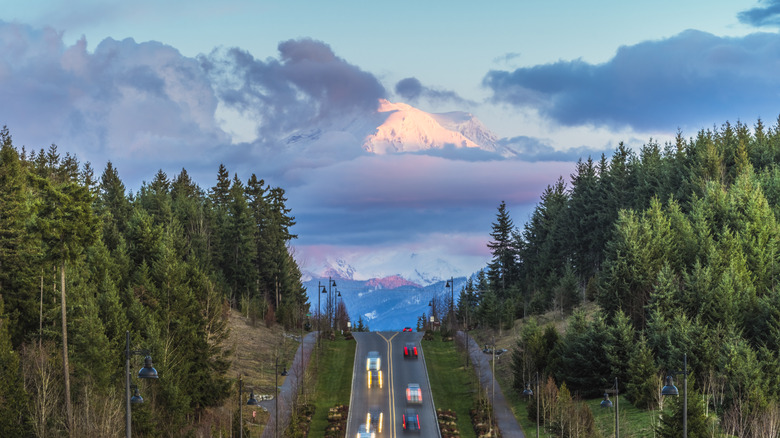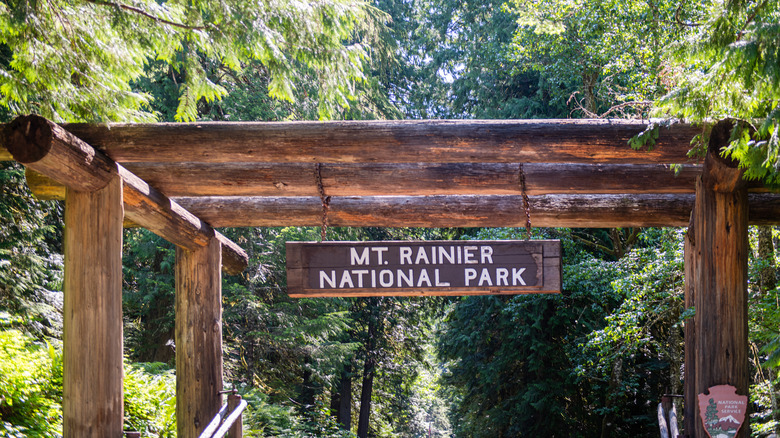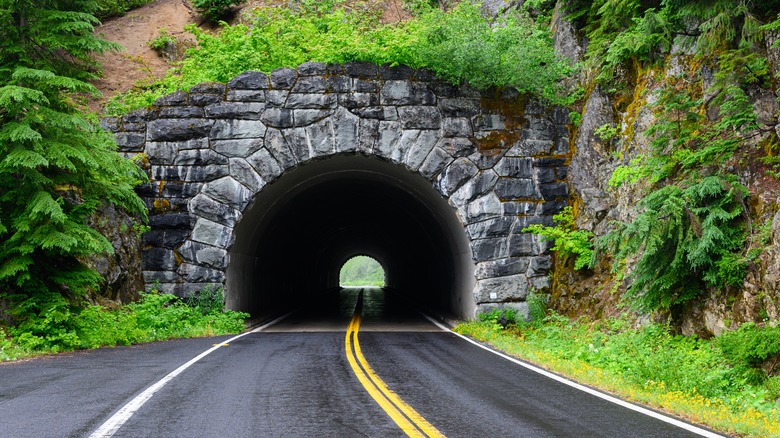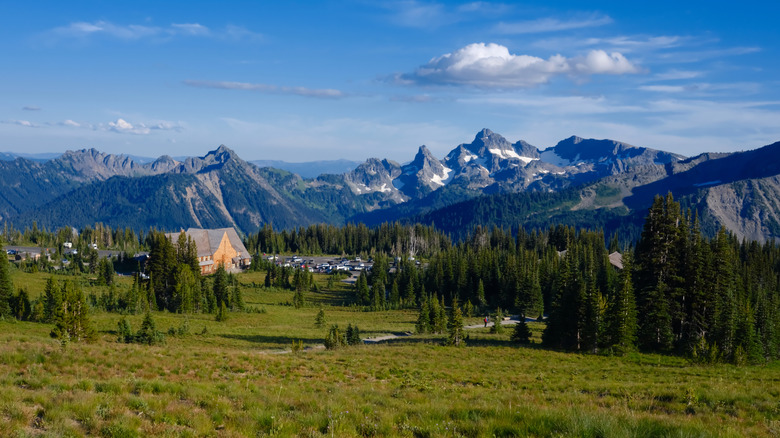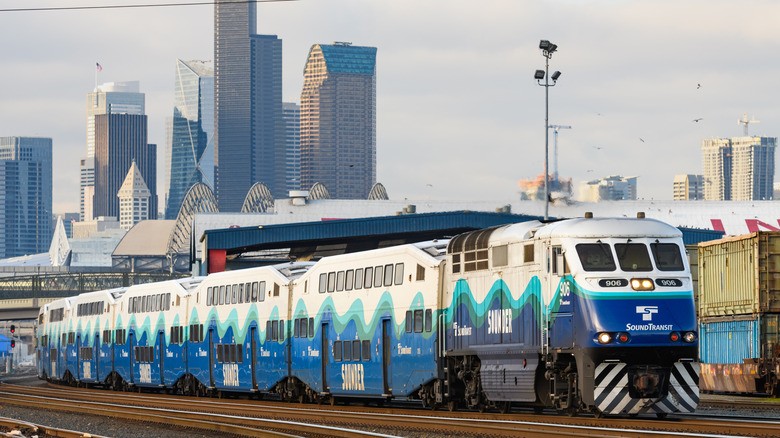Getting To Mount Rainier From Seattle: The Only Guide You Need For Your Upcoming Trip
While Seattle, Washington's "Emerald City," might be the jewel of the Pacific Northwest, there's no doubt that Mount Rainier — a symbol of the entire state— is the "Crown of the Pacific Northwest." Lush, rugged, and towering 14,400 feet tall, Mount Rainier keeps watch over the city and the Puget Sound. If you time it right, typically around summer and early fall, you'll likely see the active volcano on a clear day overlooking the city, whether you're standing atop the Space Needle or walking through Capitol Hill, Seattle's most charming neighborhood. That said, despite being just 60 miles away, getting to Mount Rainier from Seattle can be a challenge. Nonetheless, making the trip is truly worth the effort and a key part of an iconic day trip in the Pacific Northwest.
Mount Rainier sits at the heart of Mount Rainier National Park, one of three national parks in the state of Washington. Boasting plenty of relaxation and adrenaline-chasing opportunities, there's also incredible scenery to enjoy. That includes hundreds of species of wildlife, 25 glaciers, dozens of hiking trails, and one challenging summit — even for experienced trekkers.
Although there are five entrances to Mount Rainier National Park — four main and one lesser-known — this piece only covers three of the park's most popular access points. The park's Carbon River Entrance, the closest entry point to Seattle, located in the northwestern corner, was permanently closed in April 2025 due to declining confidence in the structural integrity of the 103-year-old Fairfax Bridge.
What to know before visiting Mount Rainier
According to a report by the National Park Service, in the last decade, 40% more visitors are driving to Mount Rainier during the peak summer season. Unlike nearby uncrowded North Cascades National Park — one of the most underrated national parks in America — you'll need to pre-plan your trip well before visiting Mount Rainier due to the crowds.
First, visitors will need to visit the National Park Service's official website to purchase an official pass. At the time of writing, a standard pass to access Mount Rainier National Park will set you back around $30 per car, $25 per motorcycle, and $15 for visitors without a vehicle. If you're planning on visiting the Sunrise Corridor — located near the park's northeast entrance — you'll also need to reserve an entry time in advance, as well as print or snap a screenshot of your entry time since there is no cell service. For the remainder of 2025, these reservations open at 7 p.m. local time the night before.
Once you've booked your ticket, it's a matter of choosing the best entry point. That said, no matter which entrance you choose, make sure to keep your eyes on the official road status map — which will note any closures, construction, or potentially hazardous situations — before hitting the road.
Nisqually Entrance (Southwest)
Since 1903, the Nisqually Entrance has been the primary, year-round entrance to Mount Rainier National Park. Located between Seattle (90 miles) and Portland (138 miles), it's also one of the busiest. Expect bumper-to-bumper traffic during the peak summer months, as well as on weekends in the fall. If you're relying on your GPS to get there, NPS suggests using the following address to avoid getting lost: 39000 State Route 706 E, Ashford, WA 98304. Additionally, it also recommends having a road map handy alongside your phone or car's navigation system.
If you're planning to explore the Longmire and Paradise areas in the national park, as well as the Nisqually Entrance Historic District, and the historic Longmire Village, this entrance is the closest. You'll also find permits and restrooms at the Wilderness Information Center and Longmire Museum, along with a bite to eat at the National Park Inn. From the Nisqually Entrance, you'll also have plenty of access to hiking trails for the whole family. That said, keep in mind that parking might be a challenge if you arrive late.
Activities-wise, don't miss climbing the 5.5-mile Skyline Trail, tucked away in perfectly-named Paradise, with an elevation gain of 1,700 feet and total hiking time of about 4.5 hours. If you're taking the kids or aren't up for a climb, the 1-mile paved, Nisqually Vista Trail departs from the nearby Henry M. Jackson Visitor Center at Paradise and offers incredible views of glaciers. While you can normally pop into the visitor center and fill your bottle before your trek, at the time of writing, the park has notified guests that there is no water available, so make sure to come prepared. During winter, Paradise is also one of the park's top places for snowshoeing and Nordic skiing.
Stevens Canyon Entrance (Southeast)
The Stevens Canyon Entrance is only open for a short summer season, and is located in the southeast corner of Mount Rainier National Park, approximately 94 miles southeast of Seattle. However, if the traffic isn't bad and there is no snow, consider taking the longer scenic route there. Passing through Elbe, Washington's secret Sasquatch-themed spot, it traverses the gorgeous Skate Creek Road to the charming mountain town of Packwood, located just south of the Stevens Canyon Entrance. Note that the road is paved, but is in rough condition.
Stevens Canyon is the primary access point to the Ohanapekosh River, Ohanapekosh Campground (currently under renovation until 2026), and the Ohanapekosh Visitor Center. A can't-miss hike there is the quick and easy half-mile trek along the Box Canyon Loop Trail, which joins the longer Wonderland Trail — a 93-mile arduous trek with a whopping 27,000 feet of elevation gain that's considered one of the park's most sought-after attractions.
If you're planning a visit to trek through the mythical Grove of the Patriarchs, you'll unfortunately have to wait. Due to a 2021 flood, the family-friendly, 1.5-mile trail is currently closed. If these trees could talk, they would have another incredible tale to tell, in addition to their 1,000-plus years of stories.
White River and Sunrise Corridor Entrance (Northeast)
Roughly 81 miles southeast of Seattle, you'll find the White River entrance to Mount Rainier National Park. This entrance point on the northeast side is also one of the most popular locations for visitors due to its proximity to the Sunrise Visitor Center and Day Lodge, where you can soak up some of the best views of Mount Rainier in the park.
While you're there, don't miss taking a walk along the more strenuous Sunrise Rim Trail (5 miles) and Silver Forest Trail (2.4 miles). No matter what, you'll be rewarded with incredible views of glaciers and the high alpine meadows. The Sunrise Trail is also the main trailhead for the Sourdough Ridge, Mount Fremont Fire Lookout, and Burroughs Mountain trails — three offshoots and trails that your eyes will never want to leave. If you're looking to top-up your energy with some pre-hike snacks, head over to the snack bar in the Sunrise Day Lodge for burgers, hot dogs, and even soft serve.
If you are making the drive to the White River Entrance, note that the road is only open during a short summer window — specifically from June to October — and that you will need to reserve your entrance time in advance for a weekend visit starting September 2 until the end of the season. Before the road closes for the season, make sure to visit Tipsoo Lake. Known for being one of the best places in the park for leaf peeping, you'll also spot huckleberries and gorgeous subalpine flowers.
Leave the driving to someone else
Let's say the last thing you want to do is get behind the wheel and fight traffic. While you won't find direct public transportation from Seattle to Mount Rainier National Park, or even inside the park for that matter, you can still take public transportation as far as Enumclaw and on the way back. In fact, from Pike Place Market, it's possible to reach Enumclaw in just under two hours.
From Enumclaw, visitors can hitch a ride on Talking Rocks Outdoor Company's private shuttle to the entrance of their choice. To the White River Entrance, for example, it will take less than one hour. Price-wise, the company charges $30 per hour, plus $1.20 per mile, and a $20 fee for each additional person. On top of that, riders must also pay the $30 fee to enter the park. For even more convenience, the company also offers late-night and early morning pickups, albeit for a higher fee. Moreover, it also offers emergency pickups (less than 48 hours notice) through inReach.
Finally, there are several other options for full-day tours to Mount Rainier from Seattle. For $269 per person, Adventures in Seattle offers a strenuous 6-mile day-hike to Burroughs Mountain complete with gorgeous glacial views, a local guide, and all the fixins. Meanwhile, Bearing Tours provides trips to the Nisqually entrance and Paradise. For groups of one to four guests, prices start from $885 for a 10-hour trip. Whether you're driving yourself or taking a tour, opt to leave bright and early, and expect at least two to three hours on the road each way to or from the Nisqually and White River entrances if there is little traffic and excellent road conditions.

